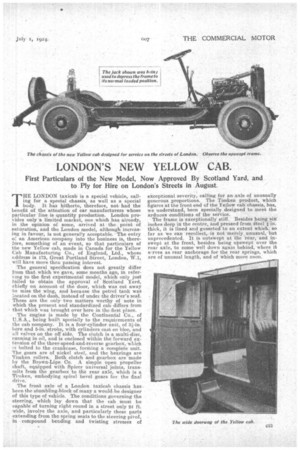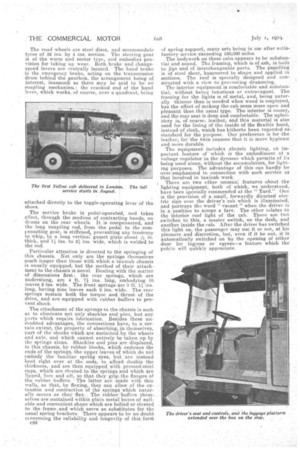LONDON'S NEW YELLOW CAB.
Page 9

Page 10

If you've noticed an error in this article please click here to report it so we can fix it.
First Particulars of the New Model, Now Approved By Scotland Yard, and to Ply for Hire on London's Streets in August.
THE LONDON taxicab is a special vehicle, calling for a special chassis, as well as a special body. ft has hitherto, therefore, not had the benefit of the attention of car manufacturers whose particular line is quantity production. London provides only 'a limited market, one which has already, in the opinion of some, arrived at the point of saturation, and the London model, although increasing in favour, is not generally acceptable. The entry an American company into the buSiness is, therefore, something of an event, so that particulars of the new Yellow cab, made in Canada for the Yellow Cab Manufacturing Co., of England, Ltd., whose fAdre,8E1 is 173, Great Portland Street, London, W.1, _ will have more than passing interest.
The general specification does not greatly differ from that which we gave, some months ago, in referling to the first experimental model, which only just tailed to obtain the approval of Scotland Yard, chiefly on account of the door, which was cut away to miss the wing, and because the petrol tank was located on the dash, instead of under the driver's seat. These are the only two matters worthy of note M which the present and standardized cab differs from that which was brought over here in the.first place.
The engine is made by the Continental Co.,. of U.S.A., being built specially to the requirements of the cab company. It is a four-cylinder unit, of 34-in. bore and 5-in, stroke, with cylinders cast en bloc, and all valves on the off side. The clutch is a multi-disc, running in oil, and is enclosed within the forward extension of the three-speed-and-reverse gearbox' which is bolted to the crankcase, forming a complete unit. The gears are of nickel steel, and the bearings are Timken rollers. Both clutch and gearbox are-made by the Brown-Lipe Co. A simple open propeller shaft, equipped with Spicer universal joints, transmits from the gearbox to the rear axle, which is a Timken, embodying spiral bevel gears for the final
drive. .
The front axle of a London taxicab chassis has been the stumbling-block of many a would-be designer of this type of vehicle. The conditions governing the steering, which lay down that the cab must be capable of turning right round in a street only 24 ft. wide, involve the axle, and particularly those parts extending from the spring seats to the steering pivot, in compound bending and twisting stresses of exceptional severity, calling for an axle of unusually generous proportions. The Timken product, -which figures at the front end of the Yellow cab chassis, has, we understand, been specially designed to meet the arduous conditions of the service.
The frame is exceptionally stiff. Besides being six inches deep in the centre, and pressed from 4teel -I in. thick, it is lined and cusseted to an extent which, so far as we can recollect, is not merely unusual, but unprecedented. It is outsWept at the rear, and inswept at the front, besides being upswept over the rear axle, to come well down again behind, where it serves as rear anchorage for the rear springs, which are of unusual length, and of which More anon. The road wheels are steel discs, and accommodate tyres of 32 ins, by 4 ins. section. The steering gear is of the worm and sector type, and embodies provision for taking up wear. Both brake and changespeed levers are centrally located. The hand brake is the emergency brake, acting on the transmission drum behind the gearbox, the arrangement being of interest, inasmuch as there may be said to be no coupling mechanism : the cranked end of the hand lever, which works, of course, over a quadrant, being attached directly to the toggie-operating lever of the shoes.
The service brake is pedal-operated, and takes effect, through the medium of contracting bands, on .drums on the rear wheels. It is compensated, and the long 'coupling rod, from the pedal to the compensating gear, is stiffened, preventing any tendency to whip, by a long vertical gusset plate about A in. thick, and i ins. to 4ins, wide, which is welded to the rod.
Particular attention is directed to the springing of this chassis. Not only are the springs themselves much longer than those with which a taxicab chassis is usually equipped, but the method of their attachment to the chassis is novel. Dealing with the matter of dimensions first: the rear springs, which are underslung, are 4 ft. 7 ins, long, embodying 110 leaves 2 ins. wide. The front springs are 2 ft. 1?-2ins. long, having nine leaves each 2 ins. wide. The rear springs sustain both the torque and thrust of the drive, and are equipped with rubber buffers to prevent shock.
The attachment of the springs to the chassis is such as to eliminate not only shackles and pins, but any. parts which require lubrication. Besides these undoubted advantages, the connections have, to a cer
tain extent, the property of absorbing-, themselves, part of the shocks which are sustained by the wheels and axle, and which cannot entirely be taken up by the springs alone. Shackles and pins are displaced, in this chassis, by rubber blocks, which embrace the ends .of the springs, the upper leaves of which do not embody the familiar spring ekes, but are instead bent right over at the ends, to afford double the thickness, and are then equipped with pressed-steel cups, which are rivetedto the springs and which are lipped, fore and aft, s6 that they grip the flanges of the -rubber buffers. .The latter are made with thin walls, so that,. by flexing, they can allow .of the ex, tension and contraction of the springs which naturally occurs as they flex, The imbiber buffers themselves are contained within plain metal boxes of suitable and convenient shape which are bolted or riveted to the frame and -which serve as substitutes for the usual spring brackets, There appears to be no doubt concerning the reliability and longevity of this forni
c22 of spring support, many sets being in use after satisfactory service exceeding 150,000-miles. The bodywork on these cabs appears to be substantial and sound. The framing, which is of ash, is built to jigs and of interchangeable parts. The paneliing is of steel sheet, hammered to shape and applied in sections. The roof is specially designed and constructed with a view to preventing drumming. The interior equipment is comfortable and substantial, without being luxurious or extravagant. The framing for the lights is of metal, and, being naturally thinner than is needed when wood is employed, has the effect of making the cab seem more open and pleasant than the usual type. The interior is recnny, and the rear seat is deep and comfortable. The upholstery is, of course, leather, and this material is also used for the lining of the inside of the flexible hood, instead of cloth, which has hitherto been regarded as standard for the purpose. Our preference is for the leather, for the twin reasons that it is more hygienic and more durable.
The equipment includes electric lighting, an important feature of which is the embodiment of a voltage regulator in the dynamo which permits of its being used alone, without the accumulators, for lighting purposes. The advantage of this can hardly he over-emphasized in connection with such service as that involved in taxicab work.
'There are two other unusual features about the lighting equipment, both of which, we understand, have been specially commended at the " Yard." One is the provision of a small, forwardly directed electric sign over the driver's cab which is illuminated, and portrays the word " vacant" when the driver is in a position to accept a fare. The other relates to the interior roof light of the cab. There are two switches to this, a master switch, on the dash, and another inside the cab. After the driver has switched this light on, the passenger may use it or not, at his pleasure and discretion, but, even if it be out, A is automatically switched on by the opening of either door for ingress or egress—a feature which the public will quickly appreciate.














































